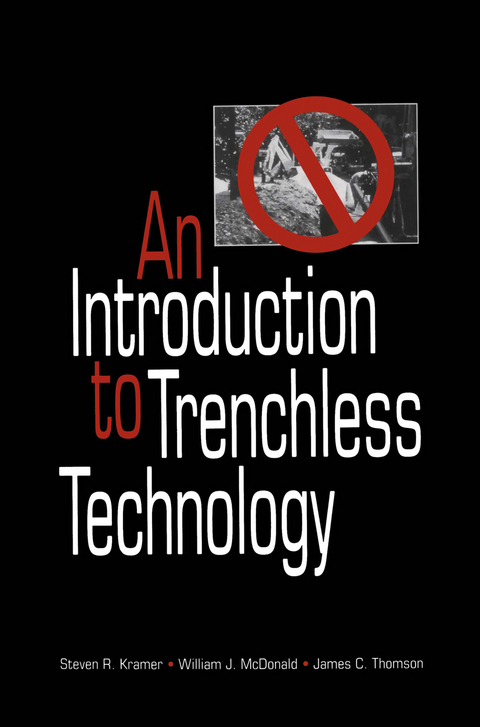
An Introduction to Trenchless Technology
Springer-Verlag New York Inc.
978-1-4613-6334-7 (ISBN)
In the past decade, the field of trenchless technology has expanded rapidly in products, equipment, and utilization. This expansion would not have occurred without a strong increase ineconomic incentives to the user. Because theoperating environment has changed, trenchless technology is often the preferred alternative to traditional methods of digging holes and installing conduits. The infrastructure in which we live has become more congested and has to beshared by several users. In addition, the cost of restoring a road or landscaped area after construction may be higher than the cost of installing the conduit. These factors add to the need for trenchless technology-the ability to dig holes without disturbing the surface. In some ways, trenchless technology is a futuristic concept. Ruth Krauss in a children'sbookofdefinitions wrote,"AHole...Is to Dig." But thisstatement is not necessarily true. Today, a hole could be to bore. Trenchless technology is not new. But it certainly has become the buzzword of the construction industry and it appears that it will have a growing impact in the way contractors, utilities, and others install new facilities. Methods to bore horizontal holes were practiced as early as the 18005, but this technology has greatly changed. Today's tools include sophisticated drilling methods, state-of the-art power systems, and electronic guidance techniques. These tools can bore faster, safer, and more accurately, and in many instances more economically, than open-cllt methods. Technology has played an important role in these advances, but economics has become the driving force in making these systems popular.
Chapter1 Introduction and Overview.- 1.1 Need for Trenchless Technology.- 1.2 Horizontal Boring Techniques.- 1.3 General Procedures.- 1.4 Selection of Method.- 1.5 Limitations.- 1.6 Future Outlook.- 1.7 Looking Ahead.- 2 Background.- 2.1 Early Underground Work.- 2.2 The Stimulus of the Industrial Revolution.- 2.3 Early Trenchless Methods-1890-1960.- 2.4 Trenchless Methods-1960-1985.- 3 Creating the Hole.- 3.1 Thrust Boring.- 3.2 Impact Moling.- 3.3 Impact Ramming.- 3.4 Rock Hammer.- 3.5 Auger Boring.- 3.6 Wet/Slurry Boring.- 3.7 Fluid Jet Cutting.- 3.8 Pipe Jacking And Microtunnelling.- 3.9 Rotary/Directional Drilling.- 4 Steerable Horizontal Boring.- 4.1 Methods of Steering the Bit 68 4.2 Available Systems.- 4.3 Planning the Job.- 4.4 Applications.- 4.5 Preventing and Controlling Problems.- 5 Pipe Jacking and Microtunnelling.- 5.1 Pipe Jacking.- 5.2 Microtunnelling.- 6 On-Line Replacement and Structural Renovation.- 6.1 Introduction.- 6.2 Options.- 6.3 On-Line Replacement.- 6.4 Renovation.- 7 Instrumentation Systems for Guided Boring.- 7.1 Unguided Systems.- 7.2 Guided Boring.- 7.3 Guidance Instrumentation Systems.- 7.4 Equipment Selection.- 7.5 Needs and Future Trends.- 8 Economics of Trenchless Technology.- 8.1 Economic Costs.- 8.2 Open-Cut Method.- 8.3 Economic Studies and Models.- 8.4 Effect of Drilling Rate.- 8.5 System Utilization.- 9 Investigation, Routing, and Location.- 9.1 Selection of Trenchless Equipment.- 9.2 Planning and Design of Project.- 9.3 Job Implementation and Precautions.- 10 Case Histories.- 10.1 Case History 1: Horizontal Drilling.- 10.2 Case History 2: Guided Piercing Tool.- 10.3 Case History 3: Microtunnelling.- 10.4 Case History 4: Pipeline Insertion Machine.- 10.5 Case History 5: Utilx Guidedril Tunnelling Machine.- 10.6 Case History 6: Microtunnelling.- 10.7 Case History 7: Renovation.- 11 Future Needs.- 11.1 The Future in Perspective.- 11.2 Attitudes and Awareness.- 11.3 technical needs.
| Zusatzinfo | XIII, 223 p. |
|---|---|
| Verlagsort | New York, NY |
| Sprache | englisch |
| Maße | 155 x 235 mm |
| Themenwelt | Naturwissenschaften ► Geowissenschaften ► Geologie |
| Naturwissenschaften ► Geowissenschaften ► Meteorologie / Klimatologie | |
| Technik ► Bauwesen | |
| ISBN-10 | 1-4613-6334-9 / 1461363349 |
| ISBN-13 | 978-1-4613-6334-7 / 9781461363347 |
| Zustand | Neuware |
| Informationen gemäß Produktsicherheitsverordnung (GPSR) | |
| Haben Sie eine Frage zum Produkt? |
aus dem Bereich


